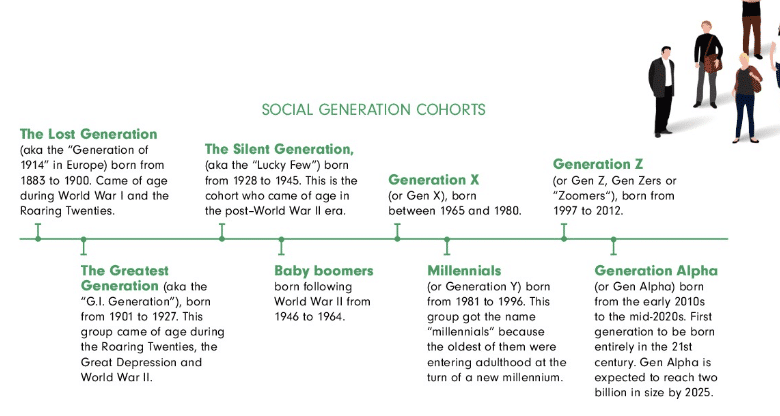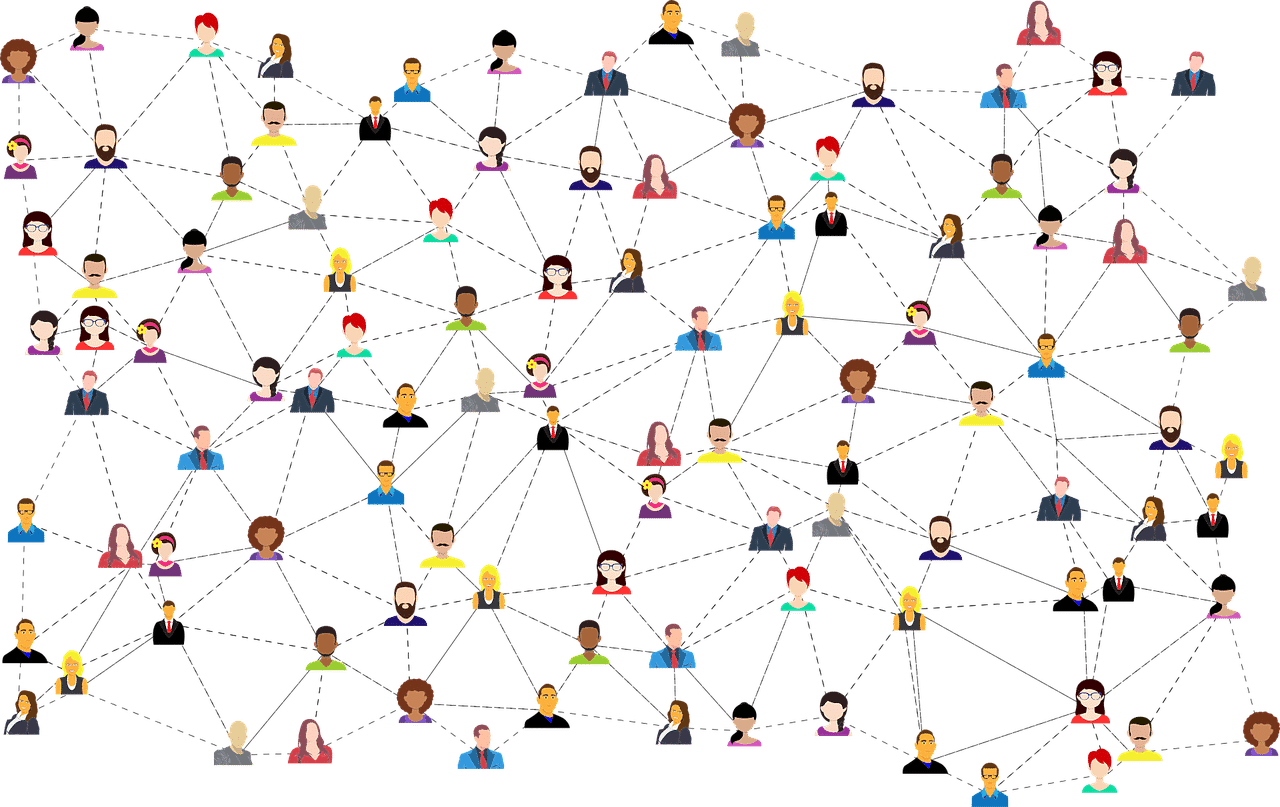Social generations are groups of people (also called ‘cohorts’) who were born in the same date range and who share similar cultural experiences. And although this approach to social generations has been gaining a lot of traction in the past few years, it is in fact an idea that has a long history and can be found in ancient literature as far back as mid-19th century.
Elsewhere in this issue you will find our ’20 Most’ article about Gen Z employees. For those of you who (like myself) have not been closely following the social generation cohorts and the corresponding descriptions, I thought it could be interesting to provide you with a simple guide to each age group. You will find a table to recap how the various social generations have been grouped together. Such a division into social generation cohorts can be helpful for HR leaders and managers, but it is important not to make any assumptions about an individual’s preferences based on their generation. Obviously, there are many variations within each region, both geographically and culturally, and the list below is rather general and only broadly indicative.

Characteristics of baby boomers:
Baby boomers are competitive and driven individuals. Because of the increase in population, boomers faced more competition for jobs when they reached working age. This resulted in a generation of hardworking employees who are proud of their jobs. They value visibility in their work, and this makes remote work environments difficult for them.
Unlike some other generations, boomers were not born into technology, and they’ve had to adjust to new technology. When commercial Internet access was first offered to customers in 1995, boomers were well into adulthood, with the youngest being 31 and the oldest being 49. And because of improved life expectancy and the baby boomers’ strong work ethic, most of them are retiring later than previous generations.
What to do for baby boomers at your workplace:
Baby boomers value the seed company or organization they work for, the positions they hold, and the length of time they have been with the organization. Recognizing their accomplishments will increase your chances of keeping them. And be sure to make time for in-person interactions. Boomers are more open to interaction in group meetings because they grew up without digital communication. If your company is entirely remote, video conferencing a few times per week is an excellent way to simulate in-person interactions.
Create a culture that welcomes an aging workforce. Ageism can be subtle or overt, and regardless of their age, employees should be provided with opportunities for advancement, access to training, recognition of their performance, and regular feedback and coaching.
Characteristics of Gen Xers:
As the children of two working parents, Gen Xers learned to be independent and solve problems on their own early in life. And they often have a good education. The decline of manufacturing jobs while Gen Xers were leaving for college resulted in a generation that saw education as a means of advancing professionally. This generation is at ease with technology. MTV, video games, and cable news were all part of Gen X’s upbringing. As a result, Generation Xers are very comfortable with technology such as computers and smartphones, as well as learning new software or programs. In addition, they prefer to keep their professional and personal lives separate. Gen Xers value work-life balance more than their predecessors.
What to do for Gen Xers at your workplace:
As baby boomers retire, Gen Xers are poised to take on leadership roles, and their direct communication style and hands-off approach to getting things done make them excellent managers. You should find ways to use Gen Xers’ leadership skills in your workforce, whether through formal positions or mentorship programs.
Allow them to continue learning because Gen Xers value education. Providing opportunities for them to further their education can improve their job satisfaction and likelihood of staying. This is possible with eLearning programs or a tuition reimbursement plan.
And you should provide work flexibility. Many employees between the ages of 46 and 55 indicated that working remotely improved their work-life balance. Furthermore, 47 per cent believe that working remotely improves job satisfaction. Giving your Gen X employees the option to work remotely and/or choose when they work will improve their work-life balance.
Characteristics of Millennials
They prefer to work together. A large majority of millennial workers say collaboration across multiple teams is critical to their job retention. Millennials, as a generation, would rather approach their work with consideration for different points of view than take top-down direction. And meaningful work motivates them. Millennials prefer work that allows them to express themselves creatively, utilize their talents, and have an impact on others. Doing work, they are passionate about is a top factor when considering future job opportunities.
They grew up in the digital age. Early versions of wi-fi were available as early as 1990, so millennials grew up with the internet and have witnessed the development of technologies such as virtual reality and artificial intelligence from the start. This resulted in a generation with a natural understanding of technology. Millennials are open to suggestions. The majority of millennials are currently employed at the entry, intermediate, or mid-level levels. As a result, they are focused on their own professional development and value feedback and mentoring from their managers.
What to do for millennials at your workplace:
Create numerous opportunities for collaboration. Collaborating on projects appeals to millennials’ desire to consider perspectives other than their own, because when multiple minds work together, different ideas are bound to be brought to the table. Even if their work is entirely independent, you can refer them to someone with whom they can bounce ideas or receive feedback on their projects.
Set up an anonymous suggestion box for employees. Millennials want to have their voices heard. A digital suggestion box is one way to solicit their feedback. There are tools for this, but you can also simply create an email address where employees can send their ideas and feedback.
Explain the significance and impact of their contributions. Millennials are motivated by meaningful work. Assist them in comprehending your organization’s mission and how it improves people’s lives or the world at large. More importantly, they must consistently measure and communicate the impact of their performance on the rest of the organization.
Provide them with actionable feedback. All employees, regardless of age, require regular, actionable feedback. Millennials are simply a generation that prioritizes it. Once a year, we recommend conducting 360-degree feedback reviews for all employees.
Characteristics of Gen Zers:
This generation is concerned with social responsibility and diversity. Almost all 13- to 17-year-olds own a smartphone. As a result, Gen Zers have grown up with instant access to the internet, news, and social media. Indeed, social media enabled them to voice their opinions on political and cultural issues before they were old enough to vote. They anticipate working with cutting-edge technology. Because Gen Zers were born into a digital world, it stands to reason that they expect technology to be integrated into their jobs.
They are moving away from institutional structures. More than previous generations, Gen Zers prefer unconventional approaches to education, finances, and employment. For example, Gen Zers are more likely to invest in cryptocurrency, whereas boomers are more likely to choose traditional investments such as bonds. In terms of education, Gen Zers continue to attend college, but they are also using tutorial videos, online classes, and real-world experience to tailor their learning to their unique, personal goals.
They want stability as well as flexibility. Events such as the Great Recession and the student loan crisis have prompted Generation Z to prioritize generating security through their choices. They want a stable income and benefits, but they also want work environments that allow them to work from anywhere and at any time.
What to do for Gen Zers at your workplace:
Make fostering a diverse and inclusive workforce a top priority. As the most racially and ethnically diverse generation to date, Generation Z anticipates diversity as the norm. If your organization’s approach to diversity and inclusion is out of date, attracting and retaining Gen Z employees will be much more difficult.
Provide a variety of opportunities for advancement. Gen Zers’ top priorities at work are broadening their skill set and gaining relevant experience. As a result, it’s critical to provide them with opportunities for growth such as on-the-job training, mentoring from experienced co-workers, and eLearning programs. Don’t just train them for their role; also help them learn about other roles within your company and try out different experiences to learn about how the organization functions as a whole.
Accept adaptability. Although a majority of Generation Z refers to themselves as the “digital generation”, many prefer to work with their team or co-workers in person. Embracing a hybrid work environment that allows Gen Zers to work both remotely and in-person is a great way to give them flexibility while also giving them facetime with their co-workers.
Bringing the generations together:
To spread generational knowledge among other generations, managers could use mentoring and reverse-mentoring to encourage diversity of thought and a culture of idea sharing. At the same time, it is important to expand communication strategies by making the same message available in multiple formats, as each generation may have a different preferred communication channel. And don’t forget to work towards building a culture of belonging, and to initiate open intergenerational conversations about the sense of individual purpose which employees experience in their work.
Based on: https://www.getapp.com/resources/characteristics-of-different-generations-in-the-workplace/













